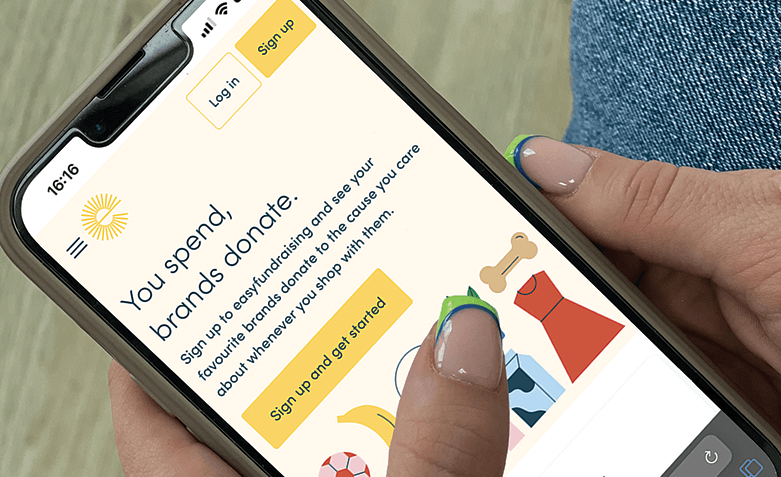
The Role of Fundraising in Educational Non-Profits
Educational non-profits have a crucial role to play in children’s lives. Some work with kids in disadvantaged areas to give them the education they deserve. Others can help bridge the gap between school and work for young people. Whatever the mission of your educational non-profit, you will always need funds to help you do your work, whether to fund new programs, buy equipment or simply to just cover your running costs. Without fundraising, it would be impossible to survive.
Here we run through some key fundraising strategies and give you a little insight on how easyfundraising can help with your ongoing fundraising efforts.
Identifying your Fundraising Goals
The first step is to understand why you need funds, and how much you can raise. Let’s set some goals.
Setting Clear, Measurable Goals
What exactly do you need funds for? Do you have a new project or initiative you want to get off the ground? Do you have key running costs that need to be met?
Knowing what you’re fundraising for is your first step, then you’ll need to clearly establish how much you need. Your goal must be achievable within your timeframe, and you’ll need to be able to measure your progress against key milestones. A fundraising plan with a detailed timeline is central to establish how you’re going to achieve your goal and when you’re going to do it. You can then hold yourself accountable against this.
Aligning Goals with your Mission
Your non-profit will have a reason to be. What is your mission? Why do you exist? What important work do you do? It’s key to align your fundraising goals to your mission. You can do this by:
- Creating a North Star: This should capture your purpose. It’s the foundation for both your organisation and fundraising efforts and everything should flow from here.
- Crafting a Mission Statement: An easy-to-remember mission statement with four or five key values will help guide you and your employees when it comes to your fundraising decision making.
- Incorporating Fundraising into Strategic Planning: Fundraising should be a concern at all levels of your organisation, including board level. This can help align fundraising efforts with the most important priorities of the organisation.
- Putting the Mission First: Fundraising must follow the mission, not lead it. Your mission is the most important aspect of your organisation. Good alignment sees the mission dictate your fundraising initiatives. And don’t adjust your mission for the sake of money.
- Declining Misaligned Fundraising: It’s important to cultivate a culture of saying no to funds and donors that misalign with your mission.
Developing a Fundraising Strategy

If you approach your fundraising strategically, you’ll have a higher chance of success. Here are some ideas to assist.
Diversifying Funding Sources
You’ll want a steady stream of income coming into your organisation to keep the coffers full and to aid with cashflow. Fundraising from an event for example, is a great way to create a bigger cash injection but you also need to focus on those tactics that give you a consistent flow too. By diversifying your funding sources, you also cover your back if a specific source dries up. Important sources to focus on include individual donors, grants, corporate sponsorship and online fundraising. The latter in particular should help you with a steady stream of ongoing funds.
Creating a Fundraising Calendar
A fundraising calendar will help you plan your fundraising year ahead and ensure you keep on track of important milestones. Your calendar should outline donor communications, campaign timelines, special events and other critical dates. It will help you plan your event strategy and your outreach to each donor group.
You should include fundraising activities, dates, departments, and the costs involved. Laying out your plan in calendar form enables you to see how much time, money and support you need to meet your goals.
Make sure you complete your calendar at least a month before any fundraising starts to give you chance to get it approved by the Board of Directors as well as to plan out the logistics. Look at past years to decide on your approach for events and to estimate costs and income for each activity.
Engaging Donors
Engaging and nurturing your relationships with key donors will be fundamental to your fundraising efforts.
Building Relationships with Donors
The first stage of building relationships with potential donors is critical. When you first meet a potential donor at a fundraising event for example, you need to make a great first impression. They need to believe in your organisation and believe in you. Your 30-second elevator pitch must be perfect. They want to instantly understand the valuable work of your organisation and see exactly how a donation from them can further your cause. After the initial meeting, you’ll need to follow up (just not too aggressively).
As soon as a donor makes a gift, you need to acknowledge it with a personal thank you. Try and send this with 24 hours to show how much the relationship means to your organisation. But your communication shouldn’t stop here. Stewardship is key to nurturing effective donor relationships. You need to be super clear that the donation is going exactly where the donor wants it to go. In your communications, you should let them know where the funds have been spent and how it is already helping your organisation in your valuable work. Stewardship helps build trust with your donor and is the foundation for a long-term relationship.
Recognition is also key. How can you recognise the valuable contributions made by your donors? Can you include them in your annual report? Do you name them in your ongoing communication emails? Whatever method you choose, know that a little recognition can go a long way.
You also need to continue to cultivate your relationship with your donors, as if you do you can hopefully rely on regular contributions. Make sure you check in with them regularly, take them for lunch and invite them to key events (and make a big deal of them at the event). As part of your ongoing fundraising strategy, it’s key to brainstorm new and innovative ways to keep your donors engaged.
Telling Impactful Stories
Stories underpin every facet of your organisation. If it’s your mission to help people with their education, the value of your organisation lies with these people. And if you’re helping to change people’s lives for the better, you need to make this front and centre in your donor strategy.
Donors respond to human stories, and if you can make them feel something they’re much more likely to get behind the valuable work you’re doing. Going back to the idea of alignment, you should only want to work with donors that align with your mission and values. When you do your donor prospecting, this is a key part of how you evaluate potential donors. If you’ve done your work properly when you tell prospects stories about your organisation, you know they will resonate with their personal values and/or experience.
Leveraging Online Fundraising Platforms

So much of your messaging today will happen online. Your website must be up to date with quality content that truly speaks to your mission and values, and you’ll need to be active on social media. But the digital world also offers a great opportunity for fundraising too.
The Power of Online Fundraising
By fundraising online, you’re not restricting yourself to engaging with just the attendees at your events. You can reach a much wider audience through your social media channels.
And if you give people an opportunity to donate online, you’re offering an accessible and convenient way for them to give funds. Online fundraising is also a fantastic way to supplement your bigger fundraising drives with ongoing funds.
Using easyfundraising for Educational Non-Profits
At easyfundraising, we offer an easy and simple way for you to supplement your fundraising efforts. All you need to do is register your good cause with us and you can start collecting donations from your supporters immediately.
So, how do they donate to you?
They simply need to create an account with us at easyfundraising. Once they do, they can shop online with any of our 7,500+ partner retailers. Each time they spend with one of our partner retailers and select you as their chosen cause, the retailer will donate to your cause out of the money they spent.
It doesn’t cost your supporters anything, and there are no fees for your organisation to sign up. All you need to do is get the word out to your supporters and promote your easyfundraising page. You can view our toolkit which gives you helpful advice on creating your page, shouting about your cause, and promoting it across your social media channels.
Evaluating Your Fundraising Efforts
So, how did you do? It’s important to evaluate your fundraising efforts after events, throughout the year and at important milestones in your fundraising calendar.
Tracking Fundraising Metrics
You should use the following metrics to track your fundraising efforts:
Return on Investment (ROI): A high ROI is a great indicator of a successful fundraiser. You calculate your ROI percentage using the following formula:
Money earned – money spent / money spent x 100
Say, you earned £5,000 in donations and spent £2,000 on the fundraising initiative, you would calculate your ROI as follows:
£5000 – £2000 / £2000 x 100 = 150%
Growth Rate: This is how quickly your fundraising efforts are growing year on year. You’ll need to look at two key factors to establish your growth rate – the amount of money raised and the number of donors or participants. You’ll then need to measure these against last year and previous years to see how you’re growing across both areas.
Average Gift Amount: When you receive gifts from donors, you’ll want to know the average amount you receive across the year. You’ll then be able to compare this year-to-year to establish if your donor program is growing. Just remember that if you secure a large gift from one donor, you may want to remove this outlier from your calculations as it could skew your data.
Average Fundraising Amount: How much have you taken in fundraising all year? Or each month? By calculating the average amount you secure from your fundraising activities, you can compare it to previous years and months to understand the growth and success of your efforts.
Donor Retention Rate: How many of your donors this year have given before and how many gave for the first time? By understanding your donor retention rate and your donor acquisition rate, you can tweak your ongoing strategy.
For example, finding new donors enables you to grow, but retaining existing donors can be more cost-effective. If you’ve got a high retention rate, you can invest in looking for new donors. But if your retention rate is low, you should devote more time and resources to strengthening existing relationships with donors as this creates a more stable foundation for growth.
Adapting and Improving Your Strategy
Having data at your fingertips across all your key metrics will help you better understand the success of your fundraising efforts, and also ensure you know how and where to tweak your strategy. If your ROI on fundraising events for example is low, are you spending too much on the events for too little in return? Could you then switch to running online events like webinars? This is a cheaper alternative that can still reach a mass audience.
Knowing your donor retention rate and acquisition rate, helps you define your donor strategy for the next year, whilst your average fundraising amount will dictate the tactics you use in your upcoming plan. Without this data and these valuable metrics, you won’t be able to build an effective and adaptable strategy. It should play a vital role in all your planning decisions.
The Power of Fundraising for Educational Non-Profits
Fundraising is the lifeblood of your organisation. Successful fundraising strategies are those that align with your goals and mission and that engage key donors and potential sponsors with emotive stories. Your donor strategy will be a crucial part of your annual fundraising plan, whilst online fundraising is becoming more valuable as a cost-effective way to engage with a wider audience. And with easyfundraising, you have a simple and ongoing way to supplement your existing fundraising efforts.
